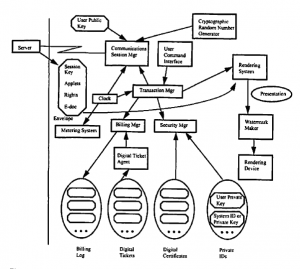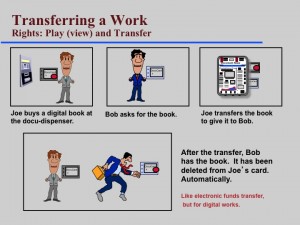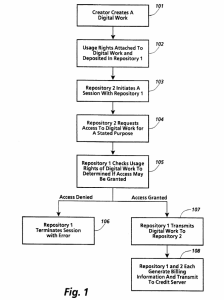Digital rights management enables distributing and selling digital works such as digitally-encoded movies, music, books, and computer games over a network. The Digital Rights Management project (1993-1998) developed concepts for electronic commerce in digital works. It showed how downloading and purchasing of digital content could be made convenient for consumers and secure for authors and publishers.
Inspiration
In the early 1990’s the research-oriented ARPANET was undergoing its transition to become the public Internet. Electronic commerce had not yet started; the dotcoms were yet to rise and fall; and the browser wars between Netscape Navigator and Microsoft Explorer were years in the future. People knew that the Internet was going to change a lot of things and some people were worried. Al Gore, then vice-president of the United States, was interested in helping the Internet to become an important economic force. He had gathered together various experts to help him understand what needed to be done. One of the problems was that there had to be a way of protecting content in digital form.
the early 1990’s the research-oriented ARPANET was undergoing its transition to become the public Internet. Electronic commerce had not yet started; the dotcoms were yet to rise and fall; and the browser wars between Netscape Navigator and Microsoft Explorer were years in the future. People knew that the Internet was going to change a lot of things and some people were worried. Al Gore, then vice-president of the United States, was interested in helping the Internet to become an important economic force. He had gathered together various experts to help him understand what needed to be done. One of the problems was that there had to be a way of protecting content in digital form.
 There was a lot of confusion ab
There was a lot of confusion ab
out protection for digital content. Some people believed that the answer was simply encryption. Others like John Perry Barlow believed that the problem was essentially insolvable. My own journey in the invention of digital rights technology is documented in the book Breakthrough.
In the months after the invention, the attitude of my colleagues at PARC went through several stages. First the consensus was that the problem was insolvable and that there had to be a flaw in the invention. However, one of my colleagues at PARC was Ralph Merkle, one of the inventors of public key cryptography. When Merkle pronounced the approach sound, the attitude shifted. It went from being impossible to being immoral! Years later, the attitude about the digital rights management continues to be controversial. I presented my own vision for the positive possibilities of digital rights technology in a paper Letting Loose the Light listed below.
Research and Spinout

 During the mid-1990’s I became an evangelist for digital rights management based on a digital rights language for expressing digital contracts and trusted systems to enforce the contracts.
During the mid-1990’s I became an evangelist for digital rights management based on a digital rights language for expressing digital contracts and trusted systems to enforce the contracts.
 I spoke to many industry groups, law school classes, publishers, and computer science colleagues. Xerox created a development group to implement the ideas.
I spoke to many industry groups, law school classes, publishers, and computer science colleagues. Xerox created a development group to implement the ideas.
In 2000, Xerox and Microsoft created a company, ContentGuard, to develop and license software for digital rights management. Its eXtensible rights Markup Language (XrML) digital rights-management software, authorizes access to content or a network service in a language that multiple systems can read. In 2005, Microsoft, Time Warner and Thomson acquired ContentGuard.
Patents
We filed patents on the core ideas, resulting in a portfolio that includes over fifty U.S. patents and many other patents internationally.
Papers
Stefik, M. (1999) The Digital Wallet and the Copyright Box: The Coming Arms Race in Trusted Systems. in Stefik, M. The Internet Edge: Social, Technical, and Legal Challenges for a Networked World. Chapter 3, pages 55-78.
Barlow, J.P., Lessig, L., Mann, C., and Stefik, M (1998). Life, Liberty, and the Pursuit of Copyright …?, The Atlantic Unbound. (The on-line version of The Atlantic Monthly.) Roundtable essays related to the cover article of the September, 1998 Atlantic Monthly. (Available on-line at Atlantic Roundtable))
Stefik, M. (1997) Trusted Systems, Scientific American, March 1997, pp. 78-81. (Available on-line at Scientific American).
Stefik, M. (1999) Stefik, M. (1997) Shifting the Possible: How digital property rights challenge us to rethink digital publishing. Berkeley Technology Law Journal, 12:1, pp 137-159, 1997.
Stefik, M. & Silverman, A. (1997) The Bit and Pendulum: Balancing the Interests of Stakeholders in Digital Publishing, American Programmer, September 1997, pp 18-35. (Also published as a chapter in Stefik, M. The Internet Edge, Cambridge, MA: The MIT Press. 1999. Also published in The Computer Lawyer, Vol. 16, No. 1, pp 1-15, January 1999.)
Stefik, M. (1996) Letting Loose the Light: Igniting commerce in electronic publication. In Stefik, M. Internet Dreams: Archetypes, Myths, and Metaphors. Cambridge, Massachusetts: MIT Press, 1996. (Also published in Proceedings: Forum on Technology-Based Intellectual Property Management,: Electronic Commerce for Content. Interactive Multimedia Association Intellectual Property Proceedings, Volume 2, August 1996, pp. 35-60).
